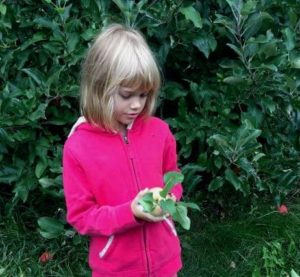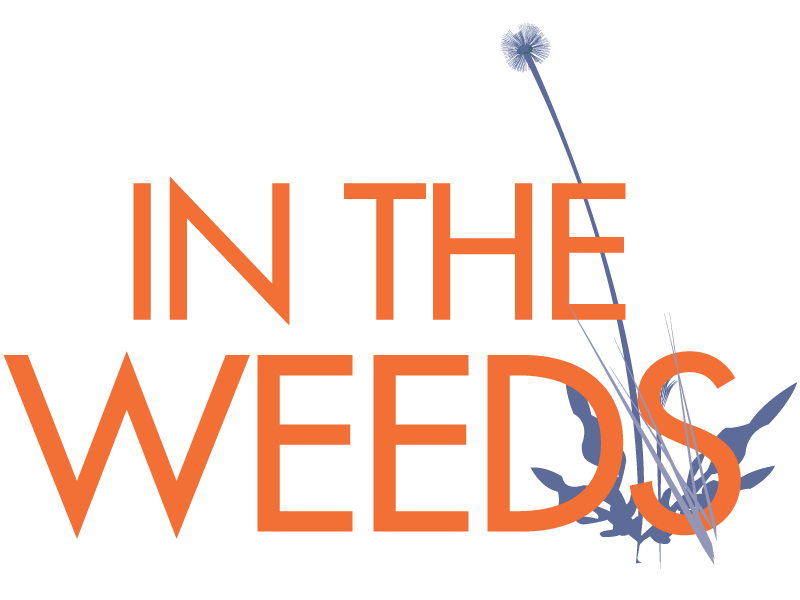
In Potawatomi, an Anishnaabe language, nouns and verbs are separated into two different classes: animate and inanimate. You speak one way of a living being and a different way of a non-living thing. Moreover, such beingness is attributed not only to humans but also to plants and animals, even to rocks, mountains, water, fire and places.
I learned this remarkable fact when I read “Learning the Grammar of Animacy,” a chapter in Robin Wall Kimmerer’s Braiding Sweetgrass. As she puts it: “Of an inanimate being, like a table, we say, “What is it?” And we answer Dopwen yewe. Table it is. But of an apple, we must say, “Who is that being?” And reply Mshimin yawe. Apple that being is.” (56)
For Kimmerer, this means that the Potawatomi speaker relates to the apple in a fundamentally different way than the English speaker does when she says, “That’s an apple.” To the former, an apple is not a thing but a living being, in kinship with human beings.
In English, we never refer to a member of our family, or indeed to any person, as it. That would be a profound act of disrespect. It robs a person of selfhood and kinship, reducing a person to a mere thing. So it is that in Potawatomi and most other indigenous languages, we use the same words to address the living world as we use for our family. Because they are our family. (55)
How are we to understand the implications of a language that attributes life and personhood to non-human beings, grammatically at least? In response, I find myself turning to other languages with which I am familiar. In French and German, for example, nouns are marked by gender and yet it is unclear to what extent this shapes people’s perceptions. Is the apple, consciously or unconsciously, female to the French speaker (who says la pomme) and male to the German speaker (who says der Apfel) or are these merely conventions?
As it turns out, animism functions grammatically in very similar way to gender. In fact, according to Wikipedia at least, it falls into the same category. The question of the why and the how of gender (for instance, why are words that have one gender in French so often the opposite in German?) is pretty complex. To understand why apple is feminine in French, for instance, one would have to look at the way in which a Latin word was dragged into what became French, via “Gallo-Roman,” a hybrid language of the period during which the Gauls or Celts were assimilated into Roman culture. In other words, the gender of pomme, which switched from neuter to feminine as it made it’s way from Latin to Gallo-Roman to French, is arguably part of the fallout of one culture rubbing up against another. (The Celtic legacy remains in English and German, whose words for apple both derive from the Celtic word ablu.)
Though these distinctions may seem arbitrary and mutable, they tell a story. In Graham Harvey’s book on animism, he includes a section on Ojibwe, a language closely related to Potawatomi. He notes that the classification of words as animate or inanimate varies among different groups of speakers, reminding us that the conventions of grammar are rooted in cultural practices.
It’s worth quoting some of the examples of words Harvey cites to give you a sense of how complex the animate/ inanimate distinction can be:
While ‘rock cliff’, aazhibik(oon) is grammatically inanimate, a ‘rock for sweat lodge’, madoodoowasin(iig) is grammatically animate. The sweat lodge itself, madoodiswan, is inanimate. Sweetgrass, wiingashk, is inanimate while tobacco is animate. A canoe, jimaan, is inanimate but a canoe rib, waaginaa, is animate. Like all trees, the birch, wiigwaas or wiigwaasi-mitig, is animate, and to remove its bark, wiigwaasike, is to act towards a person, so the verb is an animate intransitive one. The birch bark itself, wiigwaas, is inanimate, and while most objects made of it, including birch bark lodges, wiigwaasabakwaan, are inanimate, a birch bark roof wiigwaasabakwaan, is animate. The verb ‘to chew’ requires transitive animate, transitive inanimate and animate intransitive forms. It is possible to chew something or someone. All plants appear to be animate, but their fruit might be either animate or inanimate. (35)
It’s interesting that, according to Harvey, the fate of the apple in Ojibwe might differ depending on the particular group of language speakers, animate to some, inanimate to others. One can imagine that this would depend on how and when Ojibwe speakers encounter apples, what role apples play (or don’t) in their culture and so on.
Yesterday, I found myself looking at bins of tired apples in the supermarket: it was hard to think of those apples as living beings. Easier, by contrast, to recognize an apple as a living being when I go apple picking in the fall with my family, when we are in the presence of living trees, when the apples we bite are crisp and have leaves on them, reminding us of the cycle of reproduction that yields them. When they are ripe and rosy and still attached to the tree, I understand why apples in ancient times were symbols of fertility.
This contrast between supermarket and apple orchard reminds me of the importance of context: apples encountered in an orchard hint at the long and complex history that has connected the lives of apples to the lives of humans. (Indeed, the apple is possibly the oldest cultivated fruit. In North America, as Michael Pollan relates in The Botany of Desire, it helped the pioneers survive by offering an early fermented beverage.)
Just as context informs the way I think and talk about apples, surely our grammatical conventions, whether we’re talking about gender or the animate/ inanimate distinction, were shaped by cultural context. For the Potawatomi and the Ojibwe, no doubt trees and other plants were addressed as beings in their own right because of a culture that supported a view of the world as peopled by diverse living creatures.
When practices change or disappear, we are distanced from the original meaning of those conventions. In the case of the “grammar of animacy,” we have lost, tragically, most of the culture that supported it and, as Kimmerer tells us, there are only a handful of native speakers of Potawatomi left in the world. The “grammar of animism” feels distant indeed.
And yet, we still can learn from the discovery or rediscovery of what seems removed, perhaps even strange. One can’t help but wonder what it would mean to address plants as a different kind of persons, for instance – though it’s worth noting that through the work of Peter Wohlleben and others, science is beginning to catch up to native wisdom in its recognization of how complex the lives of plants are.
Since reading Kimmerer’s book, I have made an effort to speak and write about plants in language that recognizes them as non-human persons. It’s an awkward business – English isn’t built to recognize personhood in an apple or an elm. (At least in French, you can refer to an apple as “she,” an elm as “he.”) But perhaps the awkwardness serves a purpose: to remind us how far we are from this knowledge and that it takes work to learn.
But all this leads me to other questions as well: what forms of animism lie buried in our culture? Could we rediscover these and might these also help reshape our relationship to other living beings? There’s much more to uncover in this history of apples and animism.

1 comment on “On Apples and Animacy”
Comments are closed.